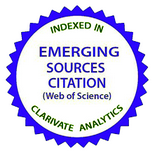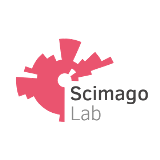Formation of Particles in Welding Fume Plasmas: Numerical Modeling and Experiment
English
DOI:
https://doi.org/10.15407/ujpe64.5.392Keywords:
gas metal arc welding, numerical modeling, particle size distribution, chemical compositionAbstract
Formation of particles in a fume plasma obtained from the gas metal arc welding is investigated by the numerical modeling of the plasma evolution. The model of welding fume plasma evolution includes the following processes: vapor emission from the arc zone and mixing with a shielding gas, plasma formation, nucleation, nucleus growth via the material condensation and coalescence, solidification of liquid droplets into primary particles, and coagulation of primary particles into inhalable particles in the breathing zone. The computed results are compared with experimental data on the specific surface area, chemical composition, and dependence of the particle sizes on the shielding gas temperature.
References
I.L. Semenov, I.V. Krivtsun, U. Reisgen. Numerical study of the anode boundary layer in atmospheric pressure arc discharges. J. Phys. D: Appl. Phys. 49, 105204 (2016). https://doi.org/10.1088/0022-3727/49/10/105204
F. Yang, M. Rong, Y. Wu, H. Sun, R. Ma, C. Niu. Numerical simulation of the eddy current effects on the Arc splitting process. Plasma Sci. Technol. 14, 974 (2012). https://doi.org/10.1088/1009-0630/14/11/05
M. Islam, A. Buijk, M. Rais-Rohani, K. Motoyama. Simulation-based numerical optimization of arc welding process for reduced distortion in welded structures. Finite Elem. Anal. Design 84, 54 (2014). https://doi.org/10.1016/j.finel.2014.02.003
D.V. Kiran, S.-J. Na. Numerical studies on submerged arc welding process. J. Weld. Joining 32(4), 1 (2014). https://doi.org/10.5781/JWJ.2014.32.4.1
S. Tashiro, M. Tanaka. Modeling of fume formation process in Arc welding. Transact. Join. Weld. Res. Inst. 40(2), 21 (2011).
M. Boselli, V. Colombo, E. Ghedini, M. Gherardi, P. Sanibondi. Two-dimensional time-dependent modelling of fume formation in a pulsed gas metal arc welding process. J. Phys. D: Appl. Phys. 46, 224006 (2013). https://doi.org/10.1088/0022-3727/46/22/224006
M. Shigeta, T. Watanabe, H. Nishiyama. Numerical investigation for nano-particle synthesis in an RF inductively coupled plasma. Thin Solid Films 457, 192 (2004). https://doi.org/10.1016/j.tsf.2003.12.020
S.L. Girshick, S.J. Warthesen. Nanoparticles and plasmas. Pure and Appl. Chem. 78, 1109 (2006). https://doi.org/10.1351/pac200678061109
I. Denysenko, N.A. Azarenkov. Formation of vertically aligned carbon nanostructures in plasmas: numerical modelling of growth and energy exchange. J. Phys. D: Appl. Phys. 44, 174031 (2011). https://doi.org/10.1088/0022-3727/44/17/174031
A.B. Murphy, M. Tanaka, K. Yamamoto, S. Tashiro, T. Sato, J.J. Lowke. Modelling of thermal plasmas for arc welding: the role of the shielding gas properties and of metal vapour. J. Phys. D: Appl. Phys. 42, 194006 (2009). https://doi.org/10.1088/0022-3727/42/19/194006
M. Schnick, U. Fuessel, M. Hertel, M. Haessler, A. Spille-Kohoff, A.B. Murphy. Modelling of gas-metal arc welding taking into account metal vapour. J. Phys. D: Appl. Phys. 43, 434008 (2010). https://doi.org/10.1088/0022-3727/43/43/434008
S. Tashiro, T. Zeniya, A.B. Murphy, M. Tanaka. Visualization of fume formation process in arc welding with numerical simulation. Surface Coat. Technol. 228, S301 (2013). https://doi.org/10.1016/j.surfcoat.2012.05.114
P. Sanibondi. Numerical investigation of the effects of iron oxidation reactions on the fume formation mechanism in arc welding. J. Phys. D: Appl. Phys. 48, 345202 (2015). https://doi.org/10.1088/0022-3727/48/34/345202
K.R. Carpenter, B.J. Monaghan, J. Norrish. Influence of shielding gas on fume size morphology and particle composition for gas metal arc welding. Iron Steel Inst. of Japan Intern. 48, 1570 (2008). https://doi.org/10.2355/isijinternational.48.1570
A. Bogaerts, M. Eckert, M. Mao, E. Neyts. Computer modelling of the plasma chemistry and plasma-based growth mechanisms for nanostructured materials. J. Phys. D: Appl. Phys. 44, 174030 (2011). https://doi.org/10.1088/0022-3727/44/17/174030
V.I. Vishnyakov, S.A. Kiro, M.V. Oprya, A.A. Ennan. Effect of shielding gas temperature on the welding fume particle formation: Theoretical model. J. Aerosol Sci. 124, 112 (2018). https://doi.org/10.1016/j.jaerosci.2018.07.006
M. Dreher, U. F?ussel and M. Schnik. In Mathematical Modelling of Weld Phenomena Vol. 9 (Technischen Univ. Graz, 2009), p. 127.
V.I. Vishnyakov, S.A. Kiro, M.V. Oprya, O.I. Shvetz, A.A. Ennan. Nonequilibrium ionization of welding fume plasmas; Effect of potassium additional agent on the particle formation. J. Aerosol Sci. 113, 178 (2017). https://doi.org/10.1016/j.jaerosci.2017.08.004
A.F. Pal', A.N. Starostin, A.V. Filippov. Charging of dust grains in a nuclear-induced plasma at high pressures. Plasma Phys. Rep. 27(2), 143 (2001). https://doi.org/10.1134/1.1348492
V.I. Vishnyakov, S.A. Kiro, M.V. Oprya, A.A. Ennan. Effects of shielding gas temperature and flow rate on the welding fume particle size distribution. J. Aerosol Sci. 114, 55 (2017). https://doi.org/10.1016/j.jaerosci.2017.09.010
J. Goree. Charging of particles in a plasma. Plasma Sources Sci. Technol. 3, 400 (1994). https://doi.org/10.1088/0963-0252/3/3/025
V.E. Fortov, A.G. Khrapak, S.A. Khrapak, V.I. Molotkov, O.F. Petrov. Dusty plasmas. Phys.-Usp. 47, 447 (2004). https://doi.org/10.1070/PU2004v047n05ABEH001689
V.I. Vishnyakov. Interaction of dust grains in strong collision plasmas: Diffusion pressure of nonequilibrium charge carriers. Phys. Plasmas 12, 103502 (2005). https://doi.org/10.1063/1.2062868
V.I. Vishnyakov. Electron and ion number densities in the space charge layer in thermal plasmas. Phys. Plasmas 13, 033507 (2006). https://doi.org/10.1063/1.2186528
B.M. Smirnov. Processes in plasma and gases involving clusters. Phys.-Usp. 40, 1117 (1997). https://doi.org/10.1070/PU1997v040n11ABEH000305
V.I. Vishnyakov, S.A. Kiro, A.A. Ennan. Multicomponent condensation in the plasma of welding fumes. J. Aerosol Sci. 74, 1 (2014). https://doi.org/10.1016/j.jaerosci.2014.04.003
V.I. Vishnyakov. Homogeneous nucleation in thermal dust-electron plasmas. Phys. Rev. E 78, 056406 (2008). https://doi.org/10.1103/PhysRevE.78.056406
V.I. Vishnyakov, S.A. Kiro, A.A. Ennan. Heterogeneous ion-induced nucleation in thermal dusty plasmas. J. Phys. D: Appl. Phys. 44, 215201 (2011). https://doi.org/10.1088/0022-3727/44/21/215201
V.I. Vishnyakov, S.A. Kiro, A.A. Ennan. Formation of primary particles in welding fume. J. Aerosol Sci. 58, 9 (2013). https://doi.org/10.1016/j.jaerosci.2012.12.003
H. Green, W. Lane. Particulate Clouds: Dusts, Smokes and Mists 2nd ed. (Van Nostrand, 1964).
P.C. Reist. Introduction to Aerosol Science (Macmillan Publishing, 1984).
N.A. Fuchs. Evaporation and Droplet Growth in Gaseous Media, edited by R.S. Bradley (Pergamon Press, 1959).
A.T. Zimmer. The influence of metallurgy on the formation of welding aerosols. J. Environ. Monit. 4, 628 (2002). https://doi.org/10.1039/B202337G
M. Okuyama, J.T. Zung. Evaporation-condensation coefficient for small droplets. J. Chem. Phys. 46, 1580 (1967). https://doi.org/10.1063/1.1840906
V.I. Vishnyakov, G.S. Dragan. Thermodynamic reasons of agglomeration of dust particles in the thermal dusty plasma. Condensed Matter Phys. 6, 687 (2003). https://doi.org/10.5488/CMP.6.4.687
V.I. Vishnyakov, S.A. Kiro, A.A. Ennan. Bimodal size distribution of primary particles in the plasma of welding fume: Coalescence of nuclei. J. Aerosol Sci. 67, 13 (2014). https://doi.org/10.1016/j.jaerosci.2013.09.007
C. Seigneur, A.B.Hudischewskyj, J.H. Seinfeld, K.T.Whitby, E.R. Whitby, J.R. Brock, H.M. Barnes. Simulation of aerosol dynamics: A comparative review of mathematical models. Aerosol Sci. Technol. 5, 205 (1986). https://doi.org/10.1080/02786828608959088
E.R. Whitby, P.H. McMurry. Modal aerosol dynamics modeling. Aerosol Sci. Technol. 27, 673 (1997). https://doi.org/10.1080/02786829708965504
P.R. Estrada, J.N. Cuzzi. Solving the coagulation equation by the moments method. Astrophys. J. 682, 515 (2008). https://doi.org/10.1086/589685
T.L. Chan, Y.H. Liu, C.K. Chan. Direct quadrature method of moments for the exhaust particle formation and evolution in the wake of the studied ground vehicle. J. Aerosol Sci. 41, 553 (2010). https://doi.org/10.1016/j.jaerosci.2010.03.005
E.R. Cohen, E.U. Vaughan. Approximate solution of the equations for aerosol agglomeration. J. Colloid Interface Sci. 35, 612 (1971). https://doi.org/10.1016/0021-9797(71)90219-0
M. Yu, J. Lin, T. Chan. A new moment method for solving the coagulation equation for particles in Brownian motion. Aerosol Sci. Technol. 42, 705 (2008). https://doi.org/10.1080/02786820802232972
Q. Shu, Y. Yang, Y. Zhai, D.M. Sun, H.J. Xiang, X.G. Gong. Size-dependent melting behavior of iron nanoparticles by replica exchange molecular dynamics. Nanoscale 4, 6307 (2012). https://doi.org/10.1039/c2nr30853c
V.I. Vishnyakov, S.A. Kiro, M.V. Oprya, O.D. Chursina, A.A. Ennan. Numerical and experimental study of the fume chemical composition in gas metal arc welding. Aerosol Sci. Engin. 2, 109 (2018). https://doi.org/10.1007/s41810-018-0028-2
M.K. Wu, S.K. Friedlander. Enhanced power law agglomerate growth in the free molecule regime. J. Aerosol Sci. 24, 273 (1992). https://doi.org/10.1016/0021-8502(93)90002-Q
V.I. Vishnyakov, S.A. Kiro, M.V. Oprya, A.A. Ennan. Coagulation of charged particles in self-organizing thermal plasmas of welding fumes. J. Aerosol Sci. 76, 138 (2014). https://doi.org/10.1016/j.jaerosci.2014.06.010
Ch. Hagwood, Yu. Sivathanu, G. Mulholland. The DMA transfer function with Brownian motion a trajectory/Monte-Carlo approach. Aerosol Sci. Technol. 30, 40 (1999). https://doi.org/10.1080/027868299304877
M.L. Eggersdorfer, S.E. Pratsinis. The structure of agglomerates consisting of polydisperse particles. Aerosol Sci. Technol. 46, 347 (2012). https://doi.org/10.1080/02786826.2011.631956
M. Miettinen, T. Torvela, J.T.T. Leskinen. Physicochemical characterization of aerosol generated in the gas tungsten arc welding of stainless steel. Ann. Occup. Hyg. 60, 960 (2016). https://doi.org/10.1093/annhyg/mew039
V.I. Vishnyakov, S.A. Kiro, M.V. Oprya, A.A. Ennan. Charge distribution of welding fume particles after charging by corona ionizer. J. Aerosol Sci. 94, 9 (2016). https://doi.org/10.1016/j.jaerosci.2015.12.003
Downloads
Published
How to Cite
Issue
Section
License
Copyright Agreement
License to Publish the Paper
Kyiv, Ukraine
The corresponding author and the co-authors (hereon referred to as the Author(s)) of the paper being submitted to the Ukrainian Journal of Physics (hereon referred to as the Paper) from one side and the Bogolyubov Institute for Theoretical Physics, National Academy of Sciences of Ukraine, represented by its Director (hereon referred to as the Publisher) from the other side have come to the following Agreement:
1. Subject of the Agreement.
The Author(s) grant(s) the Publisher the free non-exclusive right to use the Paper (of scientific, technical, or any other content) according to the terms and conditions defined by this Agreement.
2. The ways of using the Paper.
2.1. The Author(s) grant(s) the Publisher the right to use the Paper as follows.
2.1.1. To publish the Paper in the Ukrainian Journal of Physics (hereon referred to as the Journal) in original language and translated into English (the copy of the Paper approved by the Author(s) and the Publisher and accepted for publication is a constitutive part of this License Agreement).
2.1.2. To edit, adapt, and correct the Paper by approval of the Author(s).
2.1.3. To translate the Paper in the case when the Paper is written in a language different from that adopted in the Journal.
2.2. If the Author(s) has(ve) an intent to use the Paper in any other way, e.g., to publish the translated version of the Paper (except for the case defined by Section 2.1.3 of this Agreement), to post the full Paper or any its part on the web, to publish the Paper in any other editions, to include the Paper or any its part in other collections, anthologies, encyclopaedias, etc., the Author(s) should get a written permission from the Publisher.
3. License territory.
The Author(s) grant(s) the Publisher the right to use the Paper as regulated by sections 2.1.1–2.1.3 of this Agreement on the territory of Ukraine and to distribute the Paper as indispensable part of the Journal on the territory of Ukraine and other countries by means of subscription, sales, and free transfer to a third party.
4. Duration.
4.1. This Agreement is valid starting from the date of signature and acts for the entire period of the existence of the Journal.
5. Loyalty.
5.1. The Author(s) warrant(s) the Publisher that:
– he/she is the true author (co-author) of the Paper;
– copyright on the Paper was not transferred to any other party;
– the Paper has never been published before and will not be published in any other media before it is published by the Publisher (see also section 2.2);
– the Author(s) do(es) not violate any intellectual property right of other parties. If the Paper includes some materials of other parties, except for citations whose length is regulated by the scientific, informational, or critical character of the Paper, the use of such materials is in compliance with the regulations of the international law and the law of Ukraine.
6. Requisites and signatures of the Parties.
Publisher: Bogolyubov Institute for Theoretical Physics, National Academy of Sciences of Ukraine.
Address: Ukraine, Kyiv, Metrolohichna Str. 14-b.
Author: Electronic signature on behalf and with endorsement of all co-authors.

















